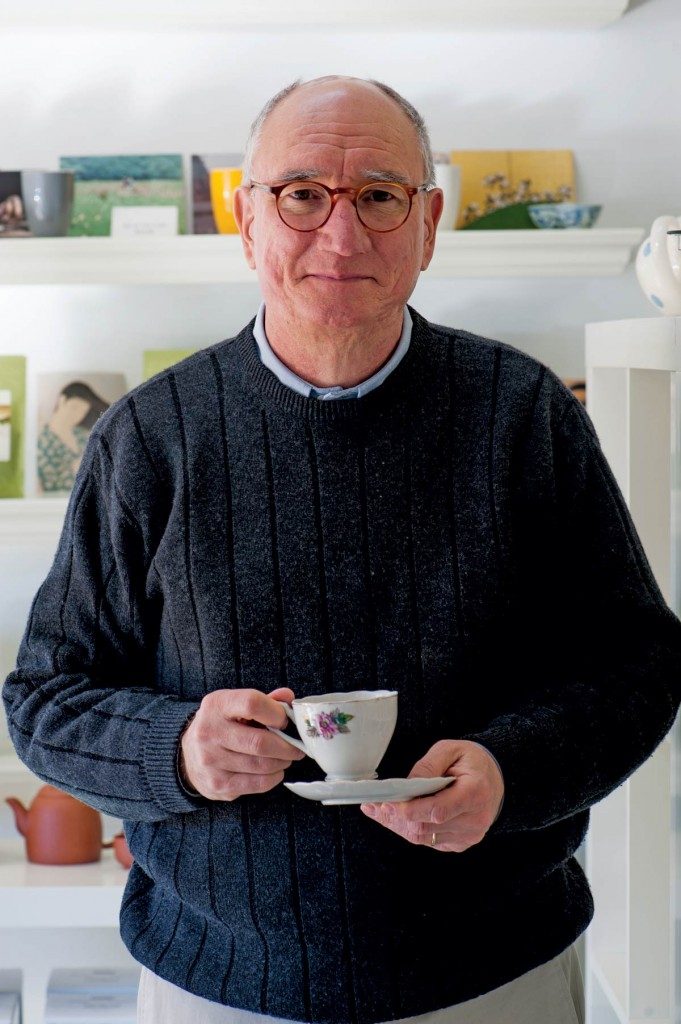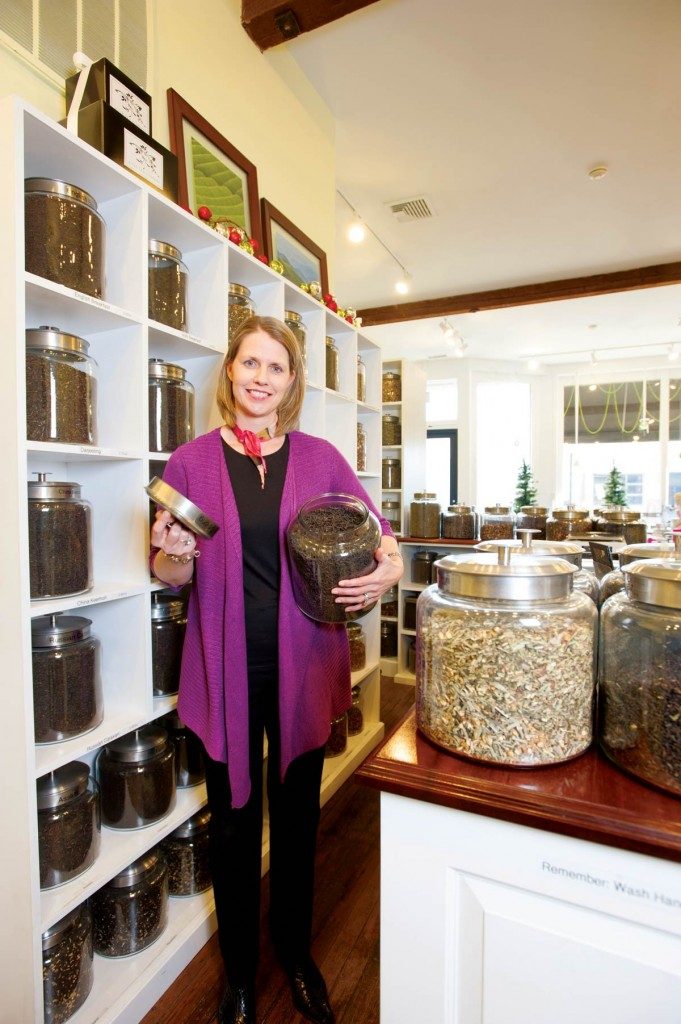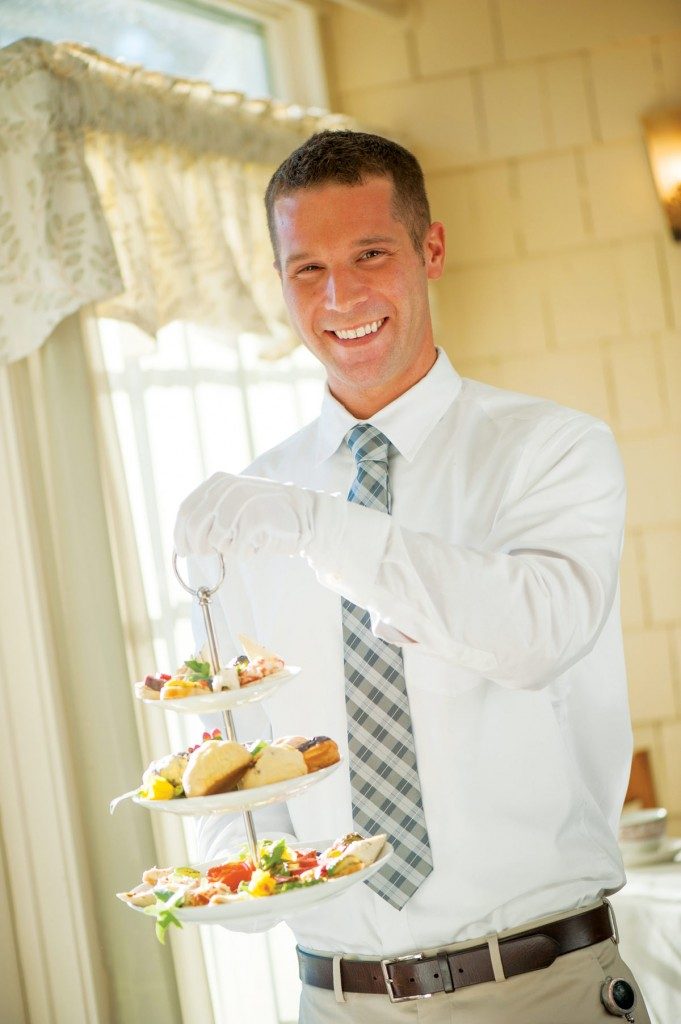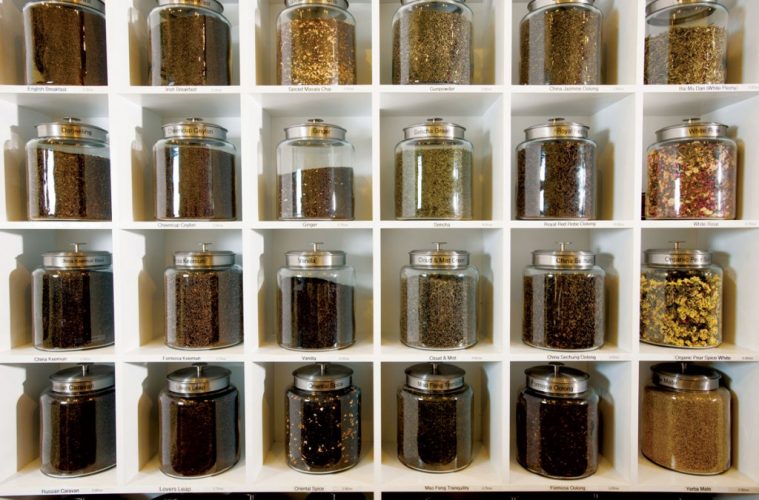The subtle complexities inside a cup of today’s second most popular potable. by Anna and David Kasabian – photographs by Kindra Clineff
When tea was first introduced to the North Shore over three centuries ago, it didn’t exactly receive rave reviews. A parcel of the newly fashionable leaf had been sent from Britain to the family of Philip English of Salem with the simple instruction that it should be boiled and served. The family complied, and after the tea was boiled, the water was discarded and the leaves were served at the table as greens. No one, it appears, asked for seconds, even after someone tossed the limp leaves in butter and added salt in a futile attempt to make them taste good.
We’ve come a long way since then, and today, tea is noted as the world’s second most consumed beverage, following water. But those who carry on a love affair with tea know that their drink of choice goes way beyond supermarket tea bags into a world whose variety and complexity can rival that of wine. Fortunately, fine tea is now more accessible and enjoyable, thanks to a number of expert tea purveyors and tearooms right here on the North Shore.
At East Wind Tea Company in Beverly Farms, you will find a robust selection of loose tea, as well as handmade teapots and other tea supplies. Owner Curtis R. Vouwie, a lifelong tea drinker, opened the business five years ago, but it really all started seven years earlier when he met Alex Fraser at one of the oldest open-air markets in London. “I liked his tea and asked if he’d like to have someone distribute it in the U.S. So that began the journey,” Vouwie says, noting he also carries tea from London-based Postcard Teas.

Curtis R. Vouwie, owner East Wind Tea Company
Vouwie prefers their teas because the leaves come directly from exceptional growers in Japan, China, Korea, Taiwan, India, and Sri Lanka. He explains the main difference between loose-leaf tea and those that come prepackaged in boxed bags is that the latter is generally made up of a blend of 15 to 30 types of tea that results in a consistent taste for mass production. Vouwie chooses his inventory by listening to his customers and bringing them what they find interesting. He also conducts his own taste tests on his London jaunts, and brews the samples his suppliers send.
When asked for his best advice for the beverage drinker moving from coffee to tea, Vouwie suggests first trying a tea that has a familiar ring, like Morning Blend. It’s similar to what most people have had bagged, but the loose version will bring a new experience.
We have all heard or read the press touting the health benefits of green tea, but Vouwie says many people say they don’t like it. “That is because they have been preparing it incorrectly, and that gets us into a discussion of how to make the best cup of tea,” he explains. “The common mistake with green tea is using water that’s too hot and brewed too long. With green tea, you need cooler water and less brewing time,” he explains. In general, according to Vouwie, creating a great cup of tea is directly related to the quality of the tea, water temperature, amount of tea, and brewing time.
“With black tea, you use hot water off the boil and brew [it for] three to four minutes. With a jasmine tea, for example, I use 180-degree water and brew [it for] only 30 seconds, and the second time I brew the same leaves for 35 seconds, and [the] third time, [for] 45 seconds. Each time, you get a lot of the antioxidants coming out of the leaves. Even though my tea is expensive, you can brew the same leaves multiple times,” he explains.
When asked for the name of one of the most unusual, strikingly flavorful teas he has discovered, Vouwie names a tea called pu’erh with leaves from a 20-year-old plant. “…It’s different; this has a very earthy flavor and is considered to have a lot of health benefits,” he says, adding, “There [are a lot] of similarities with grapes…the locality, sunlight, soil, and how it’s processed all affect the flavor.”
Vouwie says that the best triumvirate of tea equipment includes a good kettle, the right-sized teapot, and an infuser to hold the leaves. He cautions that the commonly found stainless steel tea balls are not a good choice for loose tea because they prevent the tea leaves from opening and releasing their flavor. East Wind Tea company, 8 West Street, Beverly Farms, (978) 921-4734
The Six Types of Tea All teas (except herbals) come from an evergreen shrub called Camellia sinensis. Different tea types are produced using different processing techniques, resulting in varied flavors and aromas.
White Tea Rare and expensive, leaves for white tea are picked young and barely processed. They are rolled and dried, producing a clean, subtle, and floral tea.
Green Tea Minimally processed by steaming, rolling, and drying, thereby preserving the leaf’s grassy, often fruity character.
Yellow Tea Identical to green tea except for an additional step during which the leaves are first steamed, then covered up for a period of time before drying. This enhances the aroma and flavor of the tea.
Oolong Tea Made using an elaborate and time-consuming process that results in a slightly more oxidized version of green tea, oolong is more full-bodied than green tea.
Black Tea While oolong tea is somewhat oxidized, black tea is fully oxidized, producing a deeply colored beverage with full body and aroma.
Pu’erh Tea This has become a catchall name for fermented teas, which are processed for the longest period of time and involve microbial fermentation. The resulting teas are the darkest and most richly flavored of them all.
 Amy Job, owner Jolie Tea Company
Amy Job, owner Jolie Tea Company
Jolie Tea Company’s owner, Amy Job, opened her Hamilton tea shop two years ago, and she explains this move as “that 20-year dream come true.” She says, “I feel like it’s the culmination of work experiences, interests, and a passion for plants.”
A biology major whose earlier career led her into cancer research, Job took a major turn when she decided to go to the Cambridge Culinary School, launching a second career in catering and corporate catering sales. “I left biology behind me, and it was the best thing I ever did for myself,” she explains. With the birth of her first child and a move to the suburbs, she began thinking about her passion for tea.
An admitted Francophile, drawn to the elegant way the French enjoy tea, she chose the French word “jolie” for her store name. “It is a word used to express aesthetic beauty,” she says. Her teas—more than 150—are sourced globally from India, China, Taiwan, Africa, South America, and elsewhere.
“We do so much blending here, too, and that is fun. La Fête, which means ‘holiday,’ is our blend inspired by the beverage kir royale, and has Darjeeling, dried black currant, and a touch of lemon. We also have SoHa, a South Hamilton blend of black tea flavored with vanilla and lemon,” she says.
Her advice for the new tea drinker is to first invest in a strainer, then try tea sacks, which allow you to make your own tea bag, or buy a teacup with a filter. “These are all reasonably priced [at] two to three dollars [per] ounce, which will give you 10 to 12 cups of tea. If there’s interest in trying a green tea, I suggest pomegranate green tea, which is an everyday tea, too. This is a great green tea to start with,” Job says. Her favorite tea is a lavender Earl Gray black tea, but, she says, one of the most striking flavors is [that found in] Gyokuro Jade Dew [tea]. “This would convert anybody to green tea,” she says.
“I truly believe tea drinking can be a social or personal activity…It’s about that time to slow down and reflect. I am seeing high school and college kids getting into it, the new generation…Maybe it’s because there is more of an awareness of world culture and health,” she notes.
Making the Perfect Cup of Tea
It’s really easy, but it’s worth the attention. These basic principles apply to all tea, from the most expensive Chinese Tieguanyin ($1,500 per pound) all the way down to—if you must—supermarket teabags, although better tea obviously makes a better beverage.
Good water
Always use the best water you can get, whether bottled, filtered, or, as a last resort, freshly drawn from a long-running cold tap.
Correct water temperature
Every tea is different, so ask your tea purveyor for specific advice, but in general, no tea, not even those supermarket teabags, like water straight off the boil. At the very least, let boiled water cool for a few minutes before making tea. Green teas require slightly cooler water than black teas.
Quality tea leaves
This goes without saying, of course. Just make sure that your pot, filter, or tea bag are roomy enough that the tea leaves can spread out and release their flavor efficiently. And remember, quality teas can be brewed three or more times before the tea leaves must be discarded, so they aren’t really as expensive as they may first appear.
Accurate brewing time
Again, teas vary, so ask your purveyor for advice. But as a rule of thumb, brew green teas for one to two minutes, oolongs for two to three minutes, and black teas for three to five minutes. When brewing time is over, get the leaves out of the tea before the beverage turns bitter.
Tea by the Cup & Loose Leaves to Go
Jaho Coffee & Tea The idea for Jaho Coffee & Tea was born when founder Anil Mezini traveled to Japan and was introduced to the world of tea and the concept of slow life. His love for tea grew as he traveled through Thailand, Taiwan, and South Korea, where his favorite Seoul coffee bar got him thinking about opening Jaho Coffee & Tea. In addition to an impressive number of loose teas (more than 50), you will find tea accessories, cups, and mugs. 197 Derby Street, Salem, (978) 744-4300, jaho.com
Lilyput Tea House Owners Rick and Cathy Hayes offer 36 organic loose teas by the cup or ounce, including black, white, green, oolong, pu’erh, herbals, florals, and what he terms “barefoot tea,” which is served during reflexology sessions there. Teas are imported from South Africa, India, Sri Lanka, Nepal, Bolivia, Japan, and China. “The principal reason we use organic teas is because they do not have to be washed to remove pesticides; that washing compromises the flavor,” he explains.
Rick Hayes says his most exotic tea is Earl Gray White Cream, a white tea plucked early and scented with bergamot oil and vanilla.
They also sell mugs, teapots, ceremonial cups, and a Japanese precision three-temperature tea maker. Lilyput offers classes for those who want to learn more about tea. 7 Prince Place, Newburyport, (978) 462-1377
The Tea Gathering The Tea Gathering carries more than 100 loose teas, including estate teas and pu’erh tuo cha, a type of fermented dark tea produced in Yunnan province, China. 211 Merrimack Street, Methuen, (978) 688-6602, theteagathering.com
Pleasant Street Tea Co. Owner Allison Varga offers more than 50 tea varieties from all over the world, sold by the cup, as well as loose leaves. One of the most exotic teas, according to Varga, is called Wu Wei. “That’s an herbal tea; [it’s] flavorful, sweet, spicy, [and] savory,” she says. 7 Pleasant Street, Gloucester, (978) 283-3933
The Grove Teas here, brewed with loose leaves and served by the cup, are a mix of organic and traditionally grown leaves, as well as caffeinated and herbal options. All 10 offerings come from world-renowned tea-producing areas, says owner Susan Harsch. Harsch says crimson berry is a popular new tea, and the Matcha green tea latte is another favorite. All loose tea is also sold by the ounce. 17 D Beach Street, Manchester-by-the-Sea, (978) 704-9388, thegrovema.com
 Chris Keohane at Wenham Tea House
Chris Keohane at Wenham Tea House
The Tea House Experience No matter which tea house you visit, you’ll be treated to a bit of slow living and a very civilized table ritual. Turn off your cell phone and be in the moment where good tea, conversation, and delectables will surely relax you.
Established in 1912, Wenham Tea House is one of the oldest tea houses in the country. It is now under the direct supervision of the Keohane family, which also owns Henry’s Market in Beverly.
We had the pleasure of experiencing afternoon tea here recently and dined on scones, jam, clotted cream, an assortment of delicate tea sandwiches, and, of course, tea, which came to the table in individual glass teapots with strainers and a little sand timer for monitoring the brew time. China teacups and dishes and cloth napkins maintain the civility of teatime, as did our server, who donned white cotton gloves and was highly attentive to our needs. (It was very “Downton Abbey.”)
The charming dining room is quintessential New England—wrapped in windows with pretty views and cozy cloth-covered tables, each accented with fresh flowers. A nice touch that closes teatime on a pleasant note is a beautiful little wooden music box that plays as you lift the lid to get your tab. Wenham Tea house, 4 Monument Street, Wenham, (978) 468-1398
More Tea Rooms to Try The following offer a variety of tea choices, scones, preserves, and tea sandwiches.
Crumpets Tea Room, 56 Water Street, North Andover, (978) 683-3334
Heath’s Tea Room 43 South Street, Rockport, (978) 309-3388

